Ozonelabs
Hazard to Others
  
Posts: 120
Registered: 5-4-2008
Member Is Offline
Mood: Oligomerised
|
|
Ozonelabs- Preparation of Antimony Triiodide
We decided today to prepare a little known compound Antimony Triiodide, the method is rather simple; a slurry of Antimony under toluene is stirred,
slowly a solution of Iodine in Toluene is added and the whole mixture begins to change colour as it refluxes. Some initial crystals separate and
precipitation is completed by cooling. The reagent amounts are stoichiometric.
Here, the reagents can be seen-
http://i457.photobucket.com/albums/qq300/Ozonelabs/SDC11290....
The Iodine solution in Toluene is slowly dripped in
http://i457.photobucket.com/albums/qq300/Ozonelabs/SDC11292....
The resultant beautiful red crystals
http://i457.photobucket.com/albums/qq300/Ozonelabs/SDC11296....
[Edited on 2-9-2009 by chemoleo]
[Edited on 2-9-2009 by Ozonelabs]
|
|
|
panziandi
Hazard to Others
  
Posts: 490
Registered: 3-10-2006
Location: UK
Member Is Offline
Mood: Bored
|
|
Nice! Another preparation you could consider (if you haven't already) is that of tin (IV) iodide, it can be prepared by refluxing a DCM solution of
iodine over tin metal. I expect DCM could probably be used as the solvent for iodine in this reaction you have done, and conversly toluene could
probably be used for tin (IV) iodide, although I am speculating and there maybe solubility issues. What was your yield? Slow recrystalisation might
yield some nicer larger crystals. Anything planned with the product?
|
|
|
Ozonelabs
Hazard to Others
  
Posts: 120
Registered: 5-4-2008
Member Is Offline
Mood: Oligomerised
|
|
Indeed, there were some solubility issues with the Toluene, however we will run this reaction again in DCM, benzene or Methylchloroform (The latter
two being sited in the Merck index as typical solvents for this prep).
We didn't calculate the yield as this was more of a trial run, the toluene was certianly coloured- hence it would appear that the SbI3 is partially
soluble, this is being allowed to evaporate overnight to see what sorts of crystals are produced.
|
|
|
Jor
National Hazard
   
Posts: 950
Registered: 21-11-2007
Member Is Offline
Mood: No Mood
|
|
Very nice. I would indeed try to run this in DCM. You could also use benzene or trichlorethane I guess, but if possible I would go for DCM (benzene
carcinogen, trichloroethane very expensive and ozone layer destroying).
Ozonelabs, is antimony triiodide moisture sensitive? I guess it is (arsenic halides are AFAIK), but I'm not sure.
Thanks paziandi for the great idea. I just started making SnI4. I dissolved 3,1g of iodine in about 20mL of dried DCM (over a little P4O10) and added
1g of mossy tin (made by dripping molten tin in water) and refluxed for 15 minutes. Because I wanted to go inside, I stopped refluxing and let it
stir.
How long does the reaction take? When do I know when it is finished? My idea was to simply boil away the DCM when the reaction is over. If any iodine
is still present I will simply heat the flask until the iodine is gone, as SnI4 only starts to melt at 144C.
|
|
|
ammonium isocyanate
Hazard to Others
  
Posts: 124
Registered: 13-7-2009
Location: USA - Midwest
Member Is Offline
Mood: sick 
|
|
I love how you guys integrate photos of chems and aparatuses into your write-ups. Too bad the last picture is a little out of focus.
I'm guessing SbI3 is moisture sensitive, as I know antimony chlorides and fluorides are. Are you taking any special storage measures?
|
|
|
Ozonelabs
Hazard to Others
  
Posts: 120
Registered: 5-4-2008
Member Is Offline
Mood: Oligomerised
|
|
Jor- We will try this in DCM very soon, the original reference for this procedure stated to simply reflux until no more antimony was visible, it was
clear that after an hour at reflux (when the red SbI3 crystals began to precipitate) that the reaction was essentially over. I think that distilling
the DCM is a perfectly viable way of procuring the desired compound- though Toluene has the added bonus of not having to be removed, as the bulk of
the product was insoluble.
Ammonium Isocyanate- We used sieve dried toluene 'just in case' the product was water sensitive, the Merck index sites a reaction with water forming
Antimony Oxyiodide. It was ampouled under dry nitrogen in order to preserve its integrity.
|
|
|
panziandi
Hazard to Others
  
Posts: 490
Registered: 3-10-2006
Location: UK
Member Is Offline
Mood: Bored
|
|
Jor - Here is a method I have used:
Add 2g of granulated tin to a solution of 6.35g (0.025mol)) iodine in 25mL if CCl4 in a 100mL rbf. Reflux gently, once the reaction begins the
exotherm is sufficient to maintain refluxing. The reaction is complete when violet vapour is no longer present in the flask. Filter the hot solution
from excess tin, rinse with 10mL of additional CCl4. Chill the filtrate and collect the ppt of SnI4. Additional product can be had by evaporating the
CCl4 and then chilling again to obtain a second crop. - Experimental Chemistry, A Laboratory Manual, Rendle Vokins Davis, 713121297.
Now I know this one uses carbon tetrachloride, but I have performed the reaction with DCM, years ago in an inorganic chem lab, can't find the details
but this method seems very similar, and we did the whole prep including work up and mp in 3hr lab time. If I recall I think we may have used more DCM
that they use CCl4, also I think we reduced the volume on a water bath before cooling to collect the product, and we may have recrystalised I'm not
sure. No need to predry your solvent Jor, save the phosphorus oxide 
|
|
|
Jor
National Hazard
   
Posts: 950
Registered: 21-11-2007
Member Is Offline
Mood: No Mood
|
|
Today I made some of this compound.
A week ago, 1g of mossy tin and 3,1g of iodine were added to 20mL dichloromethane (dried with P4O10). This was refluxed for a short time. I stoppered
the flask and left it stirring for a few days. There were already a lot of red crystals in the flask. I then boiled away most of the dichloromethane,
but not all. This would dissolve any unreacted iodine. I decated the deep red liquid. Then I boiled the remaining dichloromethane in a beaker.
The flask contained red crystals, with remaining pieces of tin between the red crystal mass.
The beaker contained a really dark red compound. When heated in a test tube, some (although little) purple vapour is formed, followed by the
yellow/orange vapour of SnI4 (beautiful!). The red crystals from the flask contain no iodine, and when the tin is removed with a spatula and the stuff
is heated only orange vapour is formed, and no residue remains.
So how do I remove the iodine from the impure SnI4? Washing with KI solution is not possible, as the SnI4 will also dissolve completely, and a white
precitipate is formed.
Apolar solvents also dissolve SnI4 quite well, so you cannot simply rinse it, without large losses. Heating it to evaporate the iodine is also very
hard to do, as when iodine evaporates, also large amounts of SnI4 evaporates.
Maybe dissolve the whole lot in DCM and reflux over a reducing agent? What reducing agent would be suitable, without reducing the SnI4 to SnI2?
Secondly, when SnI4 is dissolved in KI-solution a white precitipate forms. This is K2SnI6 right? It can't be hydrated stannic oxide as the precitipate
does not form (at least within a minute) without the added KI, and the the SnI4 also dissolves, although partially, giving a yellow solution.
This is how the stuff (SnI4) looks, from the pure, iodine free batch, it still contains the pieces of unreacted tin, wich by now I have removed:

The vapour of SnI4 looks as follows:

Strange thing is, that when I make a picture of the stuff in a glass container, I get exactly the same color on picture as thge last picture of
Ozonolab's SbI3, wich is not bright red. Do you also have this problem Ozonolabs, or is SbI3 actually dirty red?
The color of my stuff is what you see above.
[Edited on 6-9-2009 by Jor]
|
|
|
Mailinmypocket
International Hazard
    
Posts: 1351
Registered: 12-5-2011
Member Is Offline
Mood: No Mood
|
|
SbI3
I've been wanting to try this synthesis for a long time but never really felt like crushing antimony lumps down to powder, which was actually easier
than expected using a mortar, pestle and a bit of cursing 
The instructions were followed as per Brauer, but scaled down everything to use 1g antimony(slight excess) instead of the full 7g.
"Antimony (III) Iodide
Sbl,
Sb + 3/2l2 = Sbl3
121.8 380.7 502.5
A solution of 14 g. of I2 in 300 ml. of toluene is refluxed with
7 g. of finely pulverized Sb until the iodine color disappears. The
yellow-green solution is filtered from the unconverted Sb (best
practice is to use an immersion suction filter and propel the
fluid with compressed CO3) and allowed to crystallize, whereupon
Sbl3 precipitates as red leaflets. These are freed of toluene in a
vacuum desiccator at 40°C and then resublimed in a flow of CO2 or in vacuum."
I figured I would take some pictures of the results to share. The crystals are beautiful in solution after crystallization is complete! Very large
plates that are much nicer in person than my camera can show unfortunately.
Picture 1: One gram of freshly ground AnalaR antimony
Picture 2: Antimony on the bottom of the flask with red solution of iodine in toluene covering it, being heated in an oil bath at 125c. Eventually the
borders of the antimony it started to go greenish and flake away and eventually most of it disappeared. The solvent became a nice green\yellow at the
end of refluxing but I forgot to take a photo..
Picture 3: Beaker from above, after filtering the unreacted antimony from the toluene solution and left to stand for an hour. This was the best i
could do to show the big crystal plates.
Picture 4: Finished product after vacuum drying on a filter paper, very shiny!
Picture 5: Same as above, but in a vial
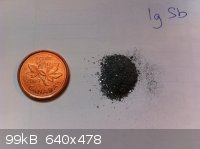 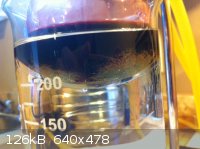 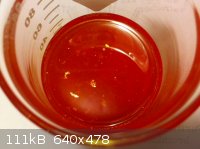 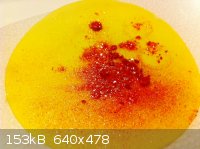 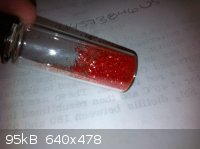
[Edited on 13-8-2012 by Mailinmypocket]
<!-- bfesser_edit_tag -->[<a href="u2u.php?action=send&username=bfesser">bfesser</a>: corrected
typo: "CO3" with author's permission]
[Edited on 9.1.14 by bfesser]
|
|
|
AndersHoveland
Hazard to Other Members, due to repeated speculation and posting of untested highly dangerous procedures!
    
Posts: 1986
Registered: 2-3-2011
Member Is Offline
Mood: No Mood
|
|
| Quote: |
Antimony penta-iodide is formed by heating antimony with excess of iodine, in a sealed tube, to a temperature not above 130 °C. It forms a dark brown
crystalline mass, melting at 78° to 79°, and is easily dissociated on heating.
The Encyclopædia britannica, Eleventh Edition, Volume 2, edited by Hugh Chisholm, p129
|
What would happen if SbI5 was reacted with anhydrous AgF ?
What type of solvent would be suitable for this?
[Edited on 14-8-2012 by AndersHoveland]
|
|
|
Lion850
National Hazard
   
Posts: 514
Registered: 7-10-2019
Location: Australia
Member Is Offline
Mood: Great
|
|
Hi guys did anyone try to make Antimony Triiodide using DCM as solvent with success? I tried but after an hour of stirring with the DCM slowly boiling
there does now seem to be any reaction (DCM works fine with Tin but maybe the Antimony needs a higher temperature?).
|
|
|
Fery
National Hazard
   
Posts: 990
Registered: 27-8-2019
Location: Czechoslovakia
Member Is Offline
|
|
Lion850, did you pulverize the antimony? The bigger surface, the faster reaction.
I did only the Sn + 2 I2 = SnI4 reaction in CCl4 solvent 20 years ago. The tin was prepared this way: Tin in a form of bar was held in a Bunsen burner
flame and drops of melted tin dropped to bench where they solidified so the final leafs were quite thin 0,5-1 mm about 1 cm in diameter, the perimeter
slightly thicker than the middle.
The lower b.p. of the solvent you used (DCM 40 C vs. CCl4 76 C vs toluene 110 C) could be perhaps compensated with increased surface of antimony.
|
|
|
Lion850
National Hazard
   
Posts: 514
Registered: 7-10-2019
Location: Australia
Member Is Offline
Mood: Great
|
|
I have Antimony powder which seems very fine. I also prepared Tin Iodide with a good yield in DCM. I am now again trying with Antimony but using
Xylene.
|
|
|